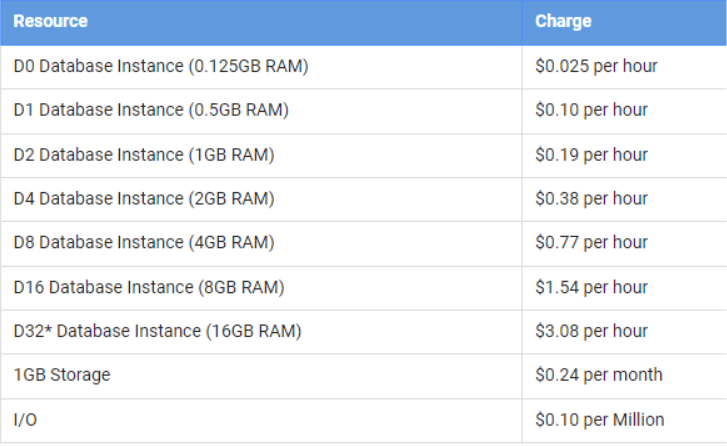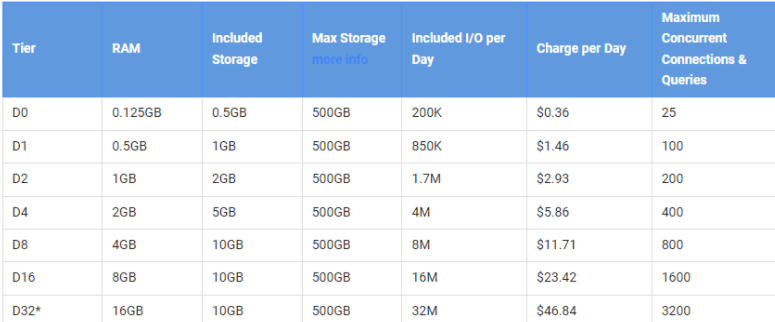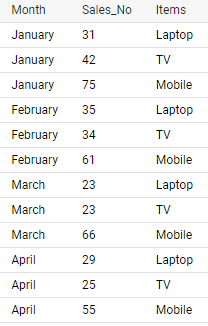BigQuery
Misc
- Also see
- Packages
- {bigrquery}
- {bigrquerystorage} - R Client for BigQuery Storage API
- BigQuery Storage API is not rate limited and per project quota do not apply. It is an rpc protocol and provides faster downloads for big results sets.
- Uses a C++ generated client combined with the {arrow} to transform the raw stream into an R object
- I think query sizes under a 1TB are free
- if you go above that, then it’s cheaper to look at flex spots
- Data Manipulation Language (DML) - Enables you to update, insert, and delete data from your BigQuery tables. (i.e. transaction operations?) (docs)
- BigQuery vs Cloud SQL
- Cloud SQL is a service where relational databases can be managed and maintained in Google Cloud Platform. It allows its users to take advantage of the computing power of the Google Cloud Platform instead of setting up their own infrastructure. Cloud SQL supports specific versions of MySQL, PostgreSQL, and SQL Server.
- BigQuery is a cloud data warehouse solution provided by Google. It also comes with a built-in query engine. Bigquery has tools for data analytics and creating dashboards and generating reports. Cloud SQL does not have strong monitoring and metrics logging like BigQuery.
- BigQuery comes with applications within itself, Cloud SQL doesn’t come with any applications.
- Cloud SQL also has more database security options than BigQuery.
- The storage space in Cloud SQL depends on the db engine being used, while that of Bigquery is equivalent to that of Google cloud storage.
- Pricing
SQL Functions
- UNNEST - BigQuery - takes an ARRAY and returns a table with a row for each element in the ARRAY (docs)
BQ Specific Expressions
Notation Rules
- Square brackets [ ] indicate optional clauses.
- Parentheses ( ) indicate literal parentheses.
- The vertical bar | indicates a logical OR.
- Curly braces { } enclose a set of options.
- A comma followed by an ellipsis within square brackets [, … ] indicates that the preceding item can repeat in a comma-separated list.
Using EXCEPT within SELECT

PIVOT for pivot tables


With more than 1 aggregate
select * from (select No_of_Items, Item, City from sale) pivot(sum(No_of_Items) Total_num, AVG(No_of_Items) Avg_num for Item in ('Laptop', 'Mobile'))
-
select * from sale unpivot(Sales_No for Items in (Laptop, TV, Mobile))It’s a pivot_longer function that puts columns, Laptop, TV, and Mobile, into Items and their values into Sales_No
Collapse columns into fewer categories
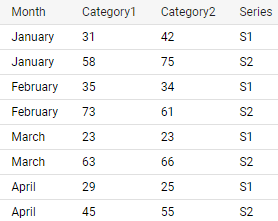
select * from sale unpivot( (Category1, Category2) for Series in ((Laptop, TV) as 'S1', (Tablet, Mobile) as 'S2') )- Columns have been collapsed into 2 categories, S1 and S2
- 2 columns for each category
- Values for each category gets its own column
- Columns have been collapsed into 2 categories, S1 and S2
GROUP BY + ROLLUP
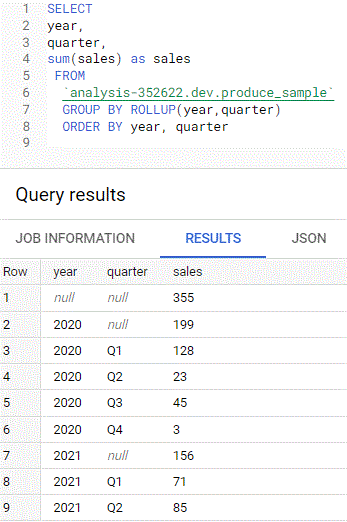
- total sales (where quarter = null) and subtotals (by quarter) by year
QUALIFY
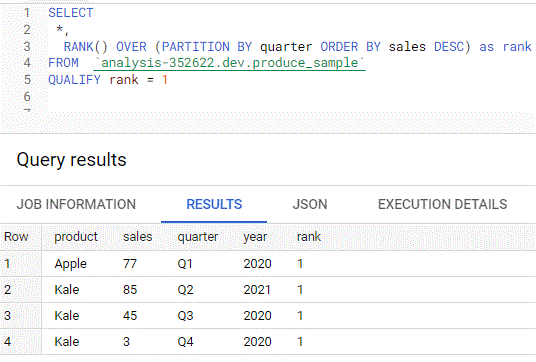
- Allows you to apply it like a WHERE condition on a column created in your SELECT statement because it’s evaluated after the GROUP BY, HAVING, and WINDOW statements
- i.e. a WHERE function that is executed towards the end of the order of operations instead of at the beginning
- Using a WHERE instead of QUALIFY, the above query looks like this

- Allows you to apply it like a WHERE condition on a column created in your SELECT statement because it’s evaluated after the GROUP BY, HAVING, and WINDOW statements
Variables (aka Parameters)
- Ways to create variables
- Using a CTE
- Basically just using a CTE and calling it a variable or table of variables
- Using BigQuery procedural language
- Using a CTE
Static values using CTE
1 variable, 1 value
-- Input your own value WITH variable AS ( SELECT 250 AS product_threshold) -- Main Query SELECT * FROM `datastic.variables.base_table`, variable WHERE product_revenue >= product_threshold- CTE
- “variable” is the name of the CTE that stores the variable
- “product_threshold” is set to 250
- Query
- The CTE is called in the FROM statement, then the “product_threshold” can be used in the WHERE expression
- CTE
1 variable, multiple values
-- Multiple values WITH variable AS ( SELECT * FROM UNNEST([250,45,75]) AS product_threshold) -- Main Query SELECT *, 'base_table_2' AS table_name FROM `datastic.variables.base_table_2`, variable WHERE product_revenue IN (product_threshold);- CTE
- “variable” is the name of the CTE that stores the variable
- Uses SELECT, FROM syntax
- list of values is unnested into the variable, “product_threshold”
- See SQL Functions for UNNEST def
- UNNEST essentially coerces the list into a 1 column vector
- Query
- The CTE is called in the FROM statement, then the “product_threshold” can be used in the WHERE expression
- Not sure why parentheses are around the variable in this case
- Table is filtered by values in the variable
- The CTE is called in the FROM statement, then the “product_threshold” can be used in the WHERE expression
- CTE
Multiple variables with multiple values
-- Multiple variables as a table WITH variable AS ( SELECT product_threshold FROM UNNEST([ STRUCT(250 AS price,'Satin Black Ballpoint Pen' AS name), STRUCT(45 AS price,'Ballpoint Led Light Pen' AS name), STRUCT(75 AS price,'Ballpoint Led Light Pen' AS name)] ) AS product_threshold) -- Main Query SELECT * FROM `datastic.variables.base_table`, variable WHERE product_revenue = product_threshold.price AND product_name = product_threshold.name- Also see (Dynamic values using CTE >> Multiple variables, 1 valuej) where “table.variable” syntax isn’t used
- CTE
- “variable” is the name of the CTE that stores the variable
- Instead of SELECT *, SELECT
is used - not sure if that’s necessary or not
- UNNEST + STRUCT coerces the array into 2 column table
- The “price” and “name” variables each have multiple values
- Each STRUCT expression is a row in the table
- Query
- The CTE is called in the FROM statement, then the “product_threshold” can be used in the WHERE expression
- Each variable is accessed by “table.variable” syntax
- Surprised IN isn’t used and that you can do this with “=” operator
Dynamic values using CTE
Value is likely to change when performing these queries with new data
1 variable, 1 value
Example: value is a statistic of a variable in a table
-- Calculate twice the average product revenue WITH variable AS ( SELECT AVG(product_revenue)*3 AS product_average FROM `datastic.variables.base_table`) -- Main Query SELECT * FROM `datastic.variables.base_table`, variable WHERE product_revenue >= product_average- For basic structure, see (Static values using CTE >> 1 variable, 1 value)
- Value is calculated in the SELECT statement and stored as “product_average”
1 variable, multiple values
Example: current product names
WITH variable AS ( SELECT product_name AS product_threshold FROM `datastic.variables.base_table` WHERE product_name LIKE '%Google%') -- Main Query SELECT * FROM `datastic.variables.base_table`, variable WHERE product_name IN (product_threshold)- For basic structure, see (Static values using CTE >> 1 variable, multiple values)
- CTE
- Product names with “Google” are stored in “product_threshold”
Multiple variables, 1 value
WITH variable AS ( SELECT MIN(order_date) AS first_order, MAX(order_date) AS last_order FROM `datastic.variables.base_table_2`) -- Main Query SELECT a.* FROM `datastic.variables.base_table` a, variable WHERE order_date BETWEEN first_order AND last_order- Basically the same as the 1 variable, 1 value example
- CTE
- variable is the name of the CTE where “first_order” and “last_order” are stored
- Query
- Not idea why “a.*” is used here
Procedural Language
- Misc
- Declare/Set
- DECLARE statement initializes variables
- SET statement will set the value for the variable
- Example: Basic
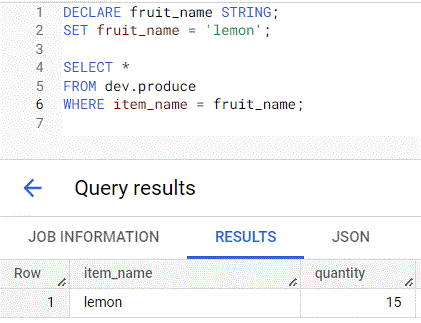
- Example: SET within IF/THEN conditional
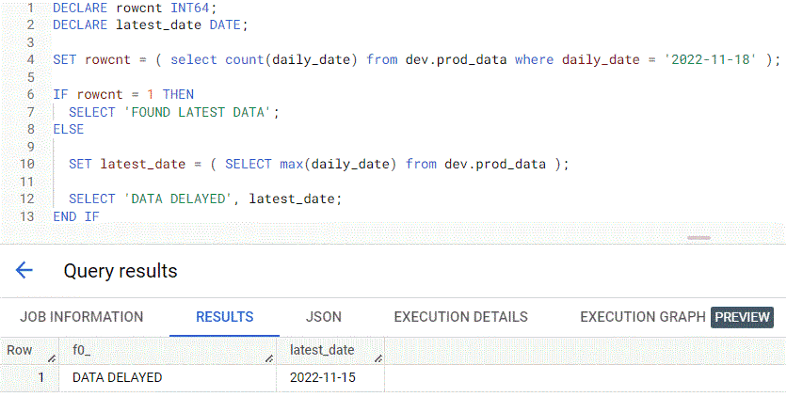
- Checks if a table had the latest data before running the remaining SQL
- Procedure
- checks the row count of the prod_data table where the daily_date field is equal to 2022–11–18 and sets that value to the rowcnt variable
- using IF-THEN conditional statements
- If rowcnt is equal to 1, meaning if there’s data found for 2022–11–18, then the string FOUND LATEST DATA will be shown.
- Else the latest_date is set to the value of the max date in the prod_data table and DATA DELAYED is displayed along with the value of latest_date.
- Result: data wasn’t found and the latest_date field shows 2022–11–15.
- Loop/Leave
- Example: Loops until a condition is met before running your SQL statements
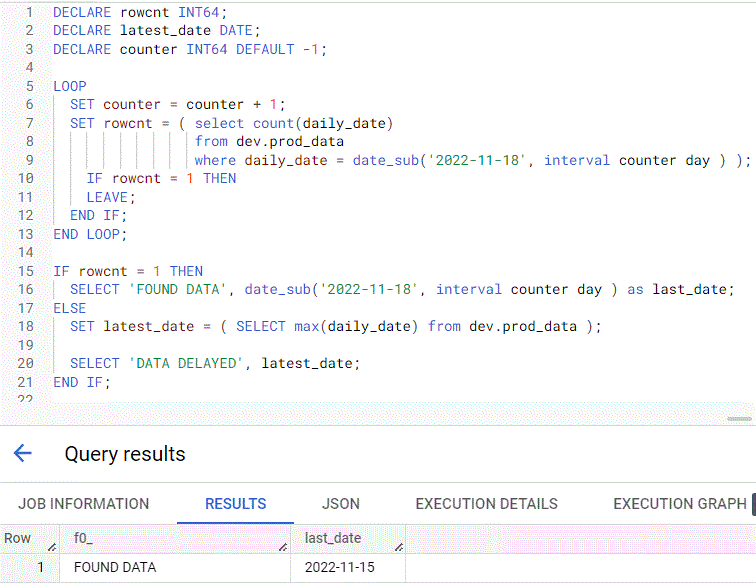
- Continues from 2nd Declare/Set example
- Procedure
- A counter variable is added with default = -1
- Subtract days from 2022–11–18 using the date_sub function by the counter variable until the rowcnt variable equals 1.
- Once rowcnt equals 1 the loop ends using the LEAVE statement
- Example: Loops until a condition is met before running your SQL statements
- Table Function
a user-defined function that returns a table
Can be used anywhere a table input is authorized
- e.g. subqueries, joins, select/from, etc.
Example: Creating
CREATE OR REPLACE TABLE FUNCTION mydataset.names_by_year(y INT64) AS SELECT year, name, SUM(number) AS total FROM `bigquery-public-data.usa_names.usa_1910_current` WHERE year = y GROUP BY year, name- y is the variable and its type is INT64
Example: Usage
SELECT * FROM mydataset.names_by_year(1950) ORDER BY total DESC LIMIT 5Example: Delete
DROP TABLE FUNCTION mydataset.names_by_year
Remote Functions
- User defined functions (UDF)
- Notes from
- Docs
- Useful in situations where you need to run code outside of BigQuery, and situations where you want to run code written in other languages
- Don’t want go overboard with remote functions because they have performance and cost disadvantages compared to native SQL UDFs
- you’ll be paying for both BigQuery and Cloud Functions.
- Use Cases
- Invoke a model on BigQuery data and create a new table with enriched data. This also works for pre-built Google models like Google Translate and Vertex Entity Extraction
- Non-ML enrichment use cases include geocoding and entity resolution.
- if your ML model is in TensorFlow, I recommend that you directly load it as a BigQuery ML model. That approach is more efficient than Remote Functions.
- Look up real-time information (e.g. stock prices, currency rates) as part of your SQL workflows.
Example: a dashboard or trading application simply calls a SQL query that filters a set of securities and then looks up the real-time price information for stocks that meet the selection criteria
WITH stocks AS ( SELECT symbol WHERE ... ) SELECT symbol, realtime_price(symbol) AS price FROM stocks- Where realtime_price is a remote function
- Replace Scheduled ETL with Dynamic ELT
- ELT as need can result in a significant reduction in storage and compute costs
- Implement hybrid cloud workflows.
- Make sure that the service you are invoking can handle the concurrency
- Invoking legacy code from SQL
- Invoke a model on BigQuery data and create a new table with enriched data. This also works for pre-built Google models like Google Translate and Vertex Entity Extraction
Flex Slots
- Docs
- Flex slots are like spot instances on aws but for running queries
- Docs
- A BigQuery slot is a virtual CPU used by BigQuery to execute SQL queries.
- BigQuery automatically calculates how many slots are required by each query, depending on query size and complexity
- Users on Flat Rate commitments no longer pay for queries by bytes scanned and instead pay for reserved compute resources (“slots” and time)
- With on-demand pricing, you pay for the cost of the query and bytes scanned
- Using Flex Slots commitments, users can now cancel the reservation anytime after 60 seconds.
- At $20/500 slot-hours, billed per second, Flex Slots can offer significant cost savings for On-Demand customers whose query sizes exceed 1TiB.
- view reservation assignments on the Capacity Management part of the BigQuery console
- An hour’s worth of queries on a 500 slot reservation for the same price as a single 4TiB on-demand query (currently priced at $5/TiB)
- Experiment
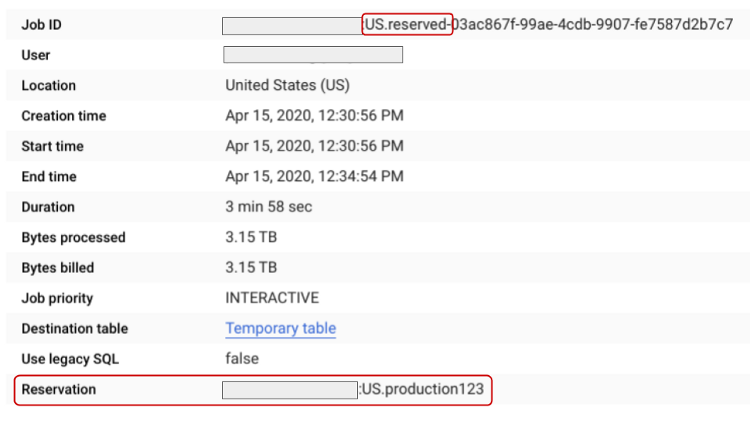
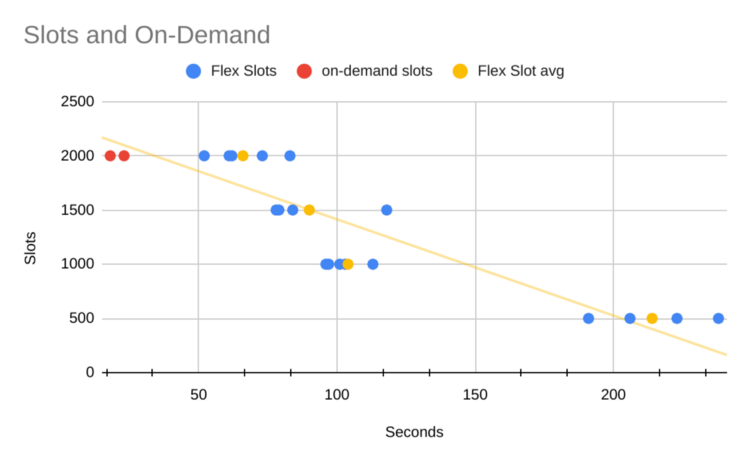
Optimization
Misc
- Also see
- Notes from 14 Ways to Optimize BigQuery SQL Performance
- Set-up Query Monitoring:
- Goals
- spot expensive/heavy queries executed by anyone from the organization. The data warehouse can be shared among the entire organization including people who don’t necessarily understand SQL but still try to look for information. An alert is to warn them about the low-quality of the query and Data Engineers can help them with good SQL practices.
- spot expensive/heavy scheduled queries at the early stage. It’s going to be risky if a scheduled query is very expensive. Having the alerting in place can prevent a high bill at the end of the month.
- understand the resource utilization and do a better job on capacity planning.
- Guide
- Goals
- “Bytes shuffled” affects query time; “Bytes processed” affects query cost
LIMITspeeds up performance, but doesn’t reduce costs- For data exploration, consider using BigQuery’s (free) table preview option instead.
- The row restriction of LIMIT clause is applied after SQL databases scan the full range of data. Here’s the kicker — most distributed database (including BigQuery) charges based on the data scans but not the outputs, which is why LIMIT doesn’t help save a dime.
- Table Preview

- allows you to navigate the table page by page, up to 200 rows at a time and it’s completely free
Avoid using
SELECT *. Choose only the relevant columns that you need to avoid unnecessary, costly full table scans- With row-based dbs, all columns get read anyway, but with columnar dbs, like BigQuery, you don’t have to read every column.
Use
EXISTSinstead ofCOUNTwhen checking if a value is present- If you don’t need the exact count, use EXISTS() because it exits the processing cycle as soon as the first matching row is found
SELECT EXISTS ( SELECT number FROM `bigquery-public-data.crypto_ethereum.blocks` WHERE timestamp BETWEEN "2018-12-01" AND "2019-12-31" AND number = 6857606 )Use Approximate Aggregate Functions
- When you have a big dataset and you don’t need the exact count, use approximate aggregate functions instead
- Unlike the usual brute-force approach, approximate aggregate functions use statistics to produce an approximate result instead of an exact result.
- Expects the error rate to be ~ 1 to 2%.
APPROX_COUNT_DISTINCT()APPROX_QUANTILES()APPROX_TOP_COUNT()APPROX_TOP_SUM()HYPERLOGLOG++
SELECT APPROX_COUNT_DISTINCT(miner) FROM `bigquery-public-data.crypto_ethereum.blocks` WHERE timestamp BETWEEN '2019-01-01' AND '2020-01-01'Replace Self-Join with Windows Function
Self-join are always inefficient and should only be used when absolutely necessary. In most cases, we can replace it with a window function.
A self-join is when a table is joined with itself.
- This is a common join operation when we need a table to reference its own data, usually in a parent-child relationship.
Example
WITH cte_table AS ( SELECT DATE(timestamp) AS date, miner, COUNT(DISTINCT number) AS block_count FROM `bigquery-public-data.crypto_ethereum.blocks` WHERE DATE(timestamp) BETWEEN "2022-03-01" AND "2022-03-31" GROUP BY 1,2 ) /* self-join */ SELECT a.miner, a.date AS today, a.block_count AS today_count, b.date AS tmr, b.block_count AS tmr_count, b.block_count - a.block_count AS diff FROM cte_table a LEFT JOIN cte_table b ON DATE_ADD(a.date, INTERVAL 1 DAY) = b.date AND a.miner = b.miner ORDER BY a.miner, a.date /* optimized */ SELECT miner, date AS today, block_count AS today_count, LEAD(date, 1) OVER (PARTITION BY miner ORDER BY date) AS tmr, LEAD(block_count, 1) OVER (PARTITION BY miner ORDER BY date) AS tmr_count, LEAD(block_count, 1) OVER (PARTITION BY miner ORDER BY date) - block_count AS diff FROM cte_table a
ORDER BYorJOINon INT64 columns if you can- When your use case supports it, always prioritize comparing INT64 because it’s cheaper to evaluate INT64 data types than strings.
- If the join keys belong to certain data types that are difficult to compare, then the query becomes slow and expensive.
- i.e. join on an int instead of a string
Instead of
NOT IN, useNOT EXISTSoperator to write anti-joins because it triggers a more resource-friendly query execution plan- anti-join - a JOIN operator with an exclusion clause
WHERE NOT IN,WHERE NOT EXISTS, etc) that removes rows if it has a match in the second table. - See article for an example
- anti-join - a JOIN operator with an exclusion clause
In any complex query, filter the data as early in the query as possible
- Apply filtering functions early and often in your query to reduce data shuffling and wasting compute resources on irrelevant data that doesn’t contribute to the final query result
- e.g.
SELECT DISTINCT,INNER JOIN,WHERE,GROUP BY
Expressions in your
WHEREclauses should be ordered with the most selective expression firstDoesn’t matter except for edge cases (e.g. the example below didn’t result in a faster query) such as:
- If you have a large number of tables in your query (10 or more).
- If you have several EXISTS, IN, NOT EXISTS, or NOT IN statements in your WHERE clause
- If you are using nested CTE (common table expressions) or a large number of CTEs.
- If you have a large number of sub-queries in your FROM clause.
Not optimized
WHERE miner LIKE '%a%' AND miner LIKE '%b%' AND miner = '0xc3348b43d3881151224b490e4aa39e03d2b1cdea'- The LIKE expressions are string searches which are expensive so they should be towards the end
- The expression with the “=” operator is the “most selective” expression since it’s for a particular value of “miner,” so it should be near the beginning
Optimized
WHERE miner = '0xc3348b43d3881151224b490e4aa39e03d2b1cdea' AND miner LIKE '%a%' AND miner LIKE '%b%'
Utilize PARTITIONS and/or CLUSTERS to significantly reduce amount of data that’s scanned
- Misc
- Also see
- DB, Engineering >> Cost Optimization >> Partitions and Indexes for CLUSTER
- SQL >> Partitions
- Partitioning Docs
- Clustering Docs
- Notes from
- original optimization article
- How to Use Partitions and Clusters in BigQuery Using SQL
- When to use Clustering instead of Partitioning:
- You need more granularity than partitioning allows.
- Your queries commonly use filters or aggregation against multiple columns.
- The cardinality of the number of values in a column or group of columns is large.
- You don’t need strict cost estimates before query execution.
- Partitioning results in a small amount of data per partition (approximately less than 10 GB). Creating many small partitions increases the table’s metadata, and can affect metadata access times when querying the table.
- Partitioning results in a large number of partitions, exceeding the limits on partitioned tables.
- Your DML operations (See Misc section) frequently modify (for example, every few minutes) most partitions in the table.
- Use BOTH partitions and clusters on tables that are bigger than 1 GB to segment and order the data.
- For big tables, it’s beneficial to both partition and cluster.
- Limits
- 4,000 partitions per table
- 4 cluster columns per table
- Info about partititoning and cluster located in Details tab of your table

- Also see
- Partitioning
Misc
- Partition columns should always be picked based on how you expect to use the data, and not depending on which column would evenly split the data based on size.
- Example: partition on county because your analysis or transformations will largely be done by county even though since some counties may be much larger than others and will cause the partitions to be substantially imbalanced.
- Partition columns should always be picked based on how you expect to use the data, and not depending on which column would evenly split the data based on size.
Types of Partition Keys
- Time-Unit Column: Tables are partitioned based on a time value such as timestamps or dates.
- DATE,TIMESTAMP, or DATETIME types
- Ingestion Time: Tables are partitioned based on the timestamp when BigQuery ingests the data.
- Uses a pseudocolumn named _PARTITIONTIME or _PARTITIONDATE with the value of the ingestion time for each row, truncated to the partition boundary (such as hourly or daily) based on UTC time
- Integer Range: Tables are partitioned based on a number. (e.g. customer_id)
- Time-Unit Column: Tables are partitioned based on a time value such as timestamps or dates.
Example: Partition by categorical
CREATE TABLE database.zoo_partitioned PARTITION BY zoo_name AS (SELECT * FROM database.zoo)Example: Partition by date; Truncate to month
CREATE OR REPLACE TABLE `datastic.stackoverflow.questions_partitioned` PARTITION BY DATE_TRUNC(creation_date,MONTH) AS ( SELECT * FROM `datastic.stackoverflow.questions`)creation_date is truncated to a month which reduces the number of partitions needed for this table
- Days would exceed the 4000 partition limit
Partition Options
partition_expiration_days: BigQuery deletes the data in a partition when it expires. This means that data in partitions older than the number of days specified here will be deleted.
require_partition_filter: Users can’t query without filtering (WHERE clause) on your partition key.
Example: Set options
CREATE OR REPLACE TABLE `datastic.stackoverflow.questions_partitioned` PARTITION BY DATE_TRUNC(creation_date,MONTH) OPTIONS(partition_expiration_days=180, require_partition_filter=TRUE) AS ( SELECT * FROM `datastic.stackoverflow.questions`) ALTER TABLE `datastic.stackoverflow.questions_partitioned` SET OPTIONS(require_partition_filter=FALSE,partition_expiration_days=10)
Querying: Don’t add a function on top of a partition key
Example: WHERE
- Bad:
WHERE CAST(date AS STRING) = '2023-12-02'- date, the partition column and filtering column, is transformed
- Seems like a bad practice in general
- Good:
WHERE date = CAST('2023-01-01' AS DATE)- The filtering condition is transformed to match the column type
- Bad:
- Clustering
Clustering divides the table into even smaller chunks than partition
A Clustered Table sorts the data into blocks based on the column (or columns) that we choose and then keeps track of the data through a clustered index.
During a query, the clustered index points to the blocks that contain the data, therefore allowing BigQuery to skip through irrelevant ones. The process of skipping irrelevant blocks on scanning is known as block pruning.
Best with values that have high cardinality, which means columns with various possible values such as emails, user ids, names, categories of a product, etc…
Able cluster on multiple columns and you can cluster different data types (STRING, DATE, NUMERIC, etc…)
Example: Cluster by categorical
CREATE TABLE database.zoo_clustered CLUSTER BY animal_name AS (SELECT * FROM database.zoo)Example: Cluster by tag
CREATE OR REPLACE TABLE `datastic.stackoverflow.questions_clustered` CLUSTER BY tags AS ( SELECT * FROM `datastic.stackoverflow.questions`)
- Partition and Cluster
Example
CREATE OR REPLACE TABLE `datastic.stackoverflow.questions_partitioned_clustered` PARTITION BY DATE_TRUNC(creation_date,MONTH) CLUSTER BY tags AS ( SELECT * FROM `datastic.stackoverflow.questions`)
- Misc
Use
ORDER BYonly in the outermost query or within window clauses (analytic functions)- Ordering is a resource intensive operation that should be left until the end since tables tend to be larger at the beginning of the query.
- BigQuery’s SQL Optimizer isn’t affected by this because it’s smart enough to recognize and run the order by clauses at the end no matter where they’re written.
- Still a good practice though.
Push complex operations, such as regular expressions and mathematical functions to the end of the query
- e.g.
REGEXP_SUBSTR()andSUM()
- e.g.
Use
SEARCH()for nested dataCan search for relevant keywords without having to understand the underlying data schema
- Tokenizes text data, making it exceptionally easy to find data buried in unstructured text and semi-structured JSON data
Traditionally when dealing with nested structures, we need to understand the table schema in advance, then appropriately flatten any nested data with UNNEST() before running a combination of WHERE and REGEXP clause to search for specific terms. These are all compute-intensive operators.
Example
-- old way SELECT `hash`, size, outputs FROM `bigquery-public-data.crypto_bitcoin.transactions` CROSS JOIN UNNEST(outputs) CROSS JOIN UNNEST(addresses) AS outputs_address WHERE block_timestamp_month BETWEEN "2009-01-01" AND "2010-12-31" AND REGEXP_CONTAINS(outputs_address, '1LzBzVqEeuQyjD2mRWHes3dgWrT9titxvq') -- with search() SELECT `hash`, size, outputs FROM `bigquery-public-data.crypto_bitcoin.transactions` WHERE block_timestamp_month BETWEEN "2009-01-01" AND "2010-12-31" AND SEARCH(outputs, ‘`1LzBzVqEeuQyjD2mRWHes3dgWrT9titxvq`’)Create a search index for the column to enable point-lookup text searches
# To create the search index over existing BQ table CREATE SEARCH INDEX my_logs_index ON my_table (my_columns);
Caching
BigQuery has a cost-free, fully managed caching feature for our queries
BigQuery automatically caches query results into a temporary table that lasts for up to 24 hours after the query has ran.
- Can toggle the feature through Query Settings on the Editor UI
Can verify whether cached results are used by checking “Job Information” after running the query. The Bytes processed should display “0 B (results cached)”.
Not all queries will be cached. Exceptions include: A query is not cached when it uses non-deterministic functions, such as CURRENT_TIMESTAMP(), because it will return a different value depending on when the query is executed.
- When the table referenced by the query received streaming inserts because any changes to the table will invalidate the cached results. If you are querying multiple tables using a wildcard.
Modeling
- Misc
- Train/Validation/Test split
- Create or choose a unique column
- Create
- Use a random number generator function such as
RAND()orUUID() - Create a hash of a single already unique field or a hash of a combination of fields that creates a unique row identifier
FARM_FINGERPRINT()is a common function- Always gives the same results for the same input
- Returns an INT64 value (essentially a number, rather than a combination of numbers and characters) that we can control with other mathematical functions such as
MOD()to produce our split ratio. - Others don’t have these qualities, e.g.
MD5()orSHA()
- Use a random number generator function such as
- Create
- Create or choose a unique column
- BigQueryML
Syntax
CREATE MODEL dataset.model_name OPTIONS(model_type=’linear_reg’, input_label_cols=[‘input_label’]) AS SELECT * FROM input_table;- Make predictions with ML.PREDICT
Example: Logistic Regression
CREATE MODEL `mydata.adults_log_reg` OPTIONS(model_type='logistic_reg') AS SELECT *, ad.income AS label FROM `mydata.adults_data` ad- Output
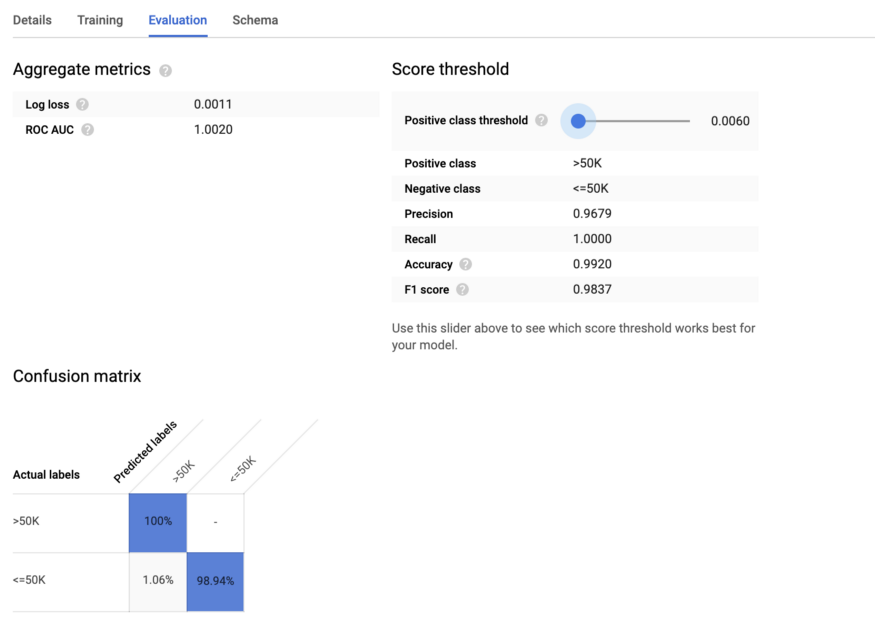
- Model appears in the sidebar alongside your data table. Click on your model to see an evaluation of the training performance.
- Output
